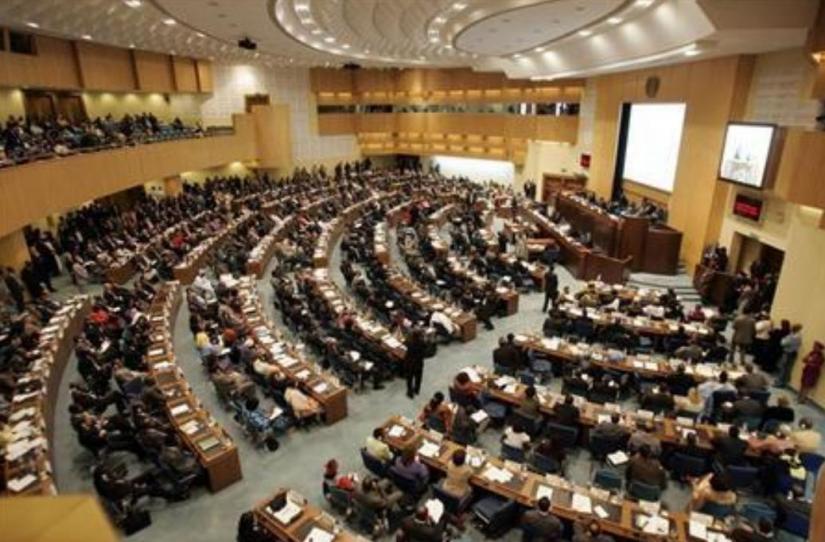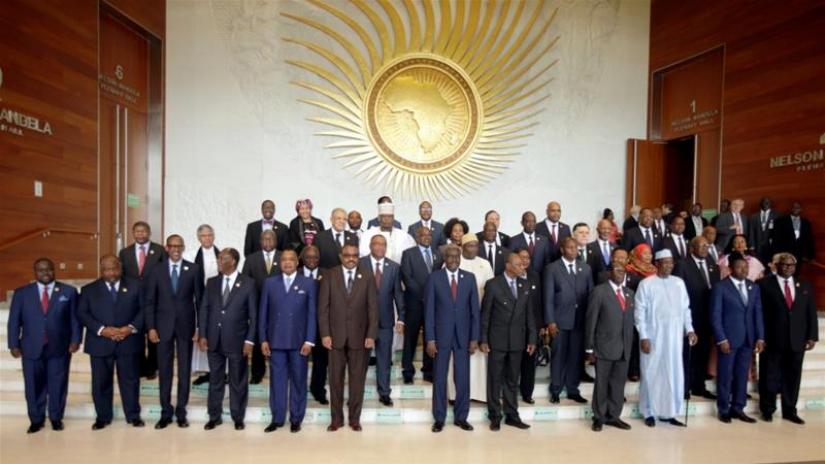 It was a beautiful summer day in 1963. His Imperial Majesty Haile Selassie I, the last of the Monarchs in Africa, was waiting patiently at the shaded front porch of the VIP enclosure with his high retinue while occasionally peeking at the clear turquoise sky of Addis Ababa. The relatively short-statured but immaculately attired and regally poised emperor of Ethiopia was calm and composed in his demeanour as he kept waiting, but not for long. The VVIP flights carrying the Heads of States and Governments of all the independent African countries began to touch down one by one and an obscure smile spread on the emperor’s time-worn face. The leaders were coming in response to his call – the call for African unity in the spirit of ‘Pan-Africanism’.
It was a beautiful summer day in 1963. His Imperial Majesty Haile Selassie I, the last of the Monarchs in Africa, was waiting patiently at the shaded front porch of the VIP enclosure with his high retinue while occasionally peeking at the clear turquoise sky of Addis Ababa. The relatively short-statured but immaculately attired and regally poised emperor of Ethiopia was calm and composed in his demeanour as he kept waiting, but not for long. The VVIP flights carrying the Heads of States and Governments of all the independent African countries began to touch down one by one and an obscure smile spread on the emperor’s time-worn face. The leaders were coming in response to his call – the call for African unity in the spirit of ‘Pan-Africanism’.
The problems challenging this initiative were formidable indeed. Occasionally, many leaders told the Imperial Majesty they all supported ‘African people demanding unity’. This seemed to be an oratorical overstatement, for African peoples at the time hardly knew each other. Land routes from one country to another were mostly primitive while railroads were built only to the sea; even today, the situation has barely changed. There was little commerce among the states of Africa. Additionally, the boundary lines that divide the continent were not drawn to accommodate tribal or racial groupings or to establish viable economies but to suit the commercial plans of the colonial powers. Of the 32 African states that won independence at the time, none was financially self‐sustaining and some were all but helpless economically. Ethiopia and Sudan, with their favourable climates and large areas of fertile land, were better off than most. Others, like the Congo, showed promise to become economically independent in time. But most of the other countries considered themselves fortunate if they possessed one or two raw materials or crops to exchange for the necessities for their own sustenance, which they had no hope of producing themselves. This was the reality for most of the independent African countries.
In this backdrop, a truly historic event unfolded when all the Heads of states and governments of 32 independent countries of the African continent came to Ethiopia at the invitation of its venerable emperor for the official groundwork of the formation of the Organization of African Union (OAU), the precursor of the current African Union (AU). Before the Ethiopian initiative, as mentioned earlier, several prominent African leaders tried to unite the African continent albeit with a grand vision and ambitious objectives but failed. In contrast, Emperor Haile Selassie I’s approach was cautious and involved limited objectives. Other African leaders including Nkrumah of Ghana, Ben Bella of Algeria, Boigny of Cote D’Ivoire, Nasser of Egypt, Kenyatta of Kenya, and Nyerere of Tanzania actively supported him and put their signatures to the founding charter of the OAU on May 25, 1963, which is now observed as ‘Africa Day’.
 Dealing with the realities of a large chunk of Africa under colonial domination and, in particular, apartheid inflicted South Africa under a minority white government, the OAU decided that its principal mission was to liberate the continent from such conditions. The ignominious injustice in South Africa that violated the most fundamental principles of the UN Charter was an insult to Africans. Liberation movements thrived with the OAU's support and solidarity, and campaigns were mounted against the apartheid system. The ethnic character of the African nations once nearly delimited in its entirety by the culture of the European colonial overlords began to be restored once the OAU was founded and promoted. Condemnations followed the prevailing injustices and Africa with OAU seemed to see a brighter day ahead. These exploits also meant that Africa was on its way to having a greater regional and continental integration as enshrined in the objectives of OAU.
Dealing with the realities of a large chunk of Africa under colonial domination and, in particular, apartheid inflicted South Africa under a minority white government, the OAU decided that its principal mission was to liberate the continent from such conditions. The ignominious injustice in South Africa that violated the most fundamental principles of the UN Charter was an insult to Africans. Liberation movements thrived with the OAU's support and solidarity, and campaigns were mounted against the apartheid system. The ethnic character of the African nations once nearly delimited in its entirety by the culture of the European colonial overlords began to be restored once the OAU was founded and promoted. Condemnations followed the prevailing injustices and Africa with OAU seemed to see a brighter day ahead. These exploits also meant that Africa was on its way to having a greater regional and continental integration as enshrined in the objectives of OAU.
Five decades after the formation of OAU, the African continent was focusing on yet another momentous initiative. As the multilateralism and larger free trade regimes around the globe have been inflicted with self-doubts and existential questions, Africa was poised to move towards implementing ‘Agenda 2063’ and a continental system called ‘African Continental Free Trade Area’ (AfCFTA). While the OAU and its successor the AU was successful in driving home their objective of liberating Africa from alien rule, this challenge of integrating Africa was daunting indeed. The practitioners and experts on similar fields remained sceptical about its prospect of such efforts from the inception. But the speed of the implementation of AfCFTA by the African countries was breathtakingly fast and kept the hopes and prospects buoyed.
The earlier drafting for AfCFTA started in 2012 while negotiations for the free trade area began in 2015. Following several rounds of intense negotiations, the historic signing of the AfCFTA Agreement occurred at the 10th Extraordinary Summit in Kigali on Mar 21, 2018, marking a milestone for the African economic integration. Surprisingly, within a year, the agreement also reached its required threshold signatories for bringing the agreement into force. By July 2019, 54 out of 55 African countries signed the Agreement. 27 countries also ratified the agreement for early implementation.
This achievement is no mean feat considering the vision of African continental integration to which AfCFTA contributes, is over five decades old. As the great Ghanaian leader Dr Kwame Nkrumah once observed “…it originated in an appreciation that the political independence achieved with decolonization would not lead to a better life for the people of Africa unless consummated with economic independence”; the need for an economic integration always remained. But in the last few years, the prospect of economic integration as an instrument of economic prosperity for Africa really thrived and finally, took shape in the form of AfCFTA.
Contradicting popular doubts and misapprehensions, the problems in the wake of old difficulties and rivalries of communicating between African states and Regional Economic Communities (REC) like COMESA, EAC, EPA, SADC etc. have actually been minimized. Although the AU Commission Chairperson admitted in his latest report that there were still several challenges - security, the spread of radicalism and terrorist cells, extremism leading to inter-communal strife and displacement, particularly during elections, encouraging progress has been recorded. Growth and development in Africa would be sustained and the second half of the current century may well be attributed to African growth.
The march towards democracy and development is also continuing, though not perhaps at the desired pace. The dream that was once cherished by so many and first materialized through the formation of OAU may come to live and prosper in the days to come through this AfCFTA.
 Today’s African economic integration may be distinctly identified in five phases. The first phase spanned early twentieth century until the formation of OAU in 1963 when the political movement was sporadic and experimental with lots of ideas, including small-scale integration and ‘Pan-African’ idiom. The second phase lasted during the formative years of OAU when the charter was signed and the objective for OAU was formalized. The third phase SAW the signing of Lagos plan of Action which introduced the ideas of sub-regional as a precursor to continental integration and focused on economic self-reliance and self-sustainment. The fourth phase may have started after 1991 following the fall of the Soviet Union and signing of Abuja Treaty, till 2012 when ideas of sub-regional economic entities emerged and gradually dissipated to give way to continental integration. A drive which included the merging of the sub-regional customs union, to a merging of free trade areas, among others to reach the current and fifth phase to cast a single FTA over African Continent rather than merging REC FTAs and focus on integration as a tool for economic diversification, structural transformation and development.
Today’s African economic integration may be distinctly identified in five phases. The first phase spanned early twentieth century until the formation of OAU in 1963 when the political movement was sporadic and experimental with lots of ideas, including small-scale integration and ‘Pan-African’ idiom. The second phase lasted during the formative years of OAU when the charter was signed and the objective for OAU was formalized. The third phase SAW the signing of Lagos plan of Action which introduced the ideas of sub-regional as a precursor to continental integration and focused on economic self-reliance and self-sustainment. The fourth phase may have started after 1991 following the fall of the Soviet Union and signing of Abuja Treaty, till 2012 when ideas of sub-regional economic entities emerged and gradually dissipated to give way to continental integration. A drive which included the merging of the sub-regional customs union, to a merging of free trade areas, among others to reach the current and fifth phase to cast a single FTA over African Continent rather than merging REC FTAs and focus on integration as a tool for economic diversification, structural transformation and development.
Thus, the objectives of the AfCFTA may be summarized as follows:
• Create a single continental market for goods and services, with free movement of business persons and investments, and thus pave the way for accelerating the establishment of the Continental Customs Union and the African customs union.
• Expand intra African trade through better harmonization and coordination of trade liberalization and facilitation regimes and instruments across RECs and across Africa in general.
• Resolve the challenges of multiple and overlapping memberships and expedite the regional and continental integration processes.
• Enhance competitiveness at the industry and enterprise level through exploiting opportunities for scale production, continental market access and better reallocation of resources.
Regarding the AfCFTA itself, an initial look would lead to viewing rosy prospects. In 2012, during the early period of drafting, seven initial clusters were identified for the continental free trade area, namely, trade policy, trade facilitation, productive capacity, trade-related infrastructure, trade finance, trade information, and factor market integration. A singular market spanning 55 countries, 1.3 billion people, untapped/under-utilized natural resources and a combined GDP of USD 2.3 trillion, an open sky for connectivity and a free movement for people, goods, services and investment, among others, are to be attained through AfCFTA. This would achieve technology transfer, industrial development, diversification of sources of growth, and Intra-African exports which were 16.6% of total exports in 2017, compared with 68% in Europe and 59% in Asia. It is the largest trade agreement since the formation of WTO and would be the biggest continental free trade area once fully operational. As the threshold number of country ratifications was reached unprecedentedly within one-year, international organizations like UN Economic Commission for Africa forecast that the agreement would likely increase the intra-Africa trade by 50-100%, depending on the extent to which Non-Tariff/Para-Tariff Barriers would be reduced by 2030.
In Ethiopia, the birthplace of the OAU, the whole concept of AfCFTA is often described simply in ‘Merkato’ terms. Merkato which literally means ‘New Market’ in Amharic language is the name of the biggest open-air market in the African continent housed in the Addis Ketema district in Addis Ababa. In its heydays, it received merchants and visitors from nearly all corners of Africa and beyond. At present d it is just a big market full of retail trading shops due to restrictions of currency trading and the conservation of domestic products and interests. Accessibility for foreign merchants to bring products directly has become limited per se. In the same vein, the ambitious target of AfCFTA is expected to create the true new Merkato within Africa but as it is often observed, in the history of African economic integration and during evolutions of other free trade areas, interests become tunnel-visioned when it comes to choosing between individual protectionism and collective gains. Still, the AU’s new initiative created new hope because of the active political will of the African Member States transpired through the aggressive pursuit of the agreement and minimalizing the number of negotiated documents.
As for the present scenario, the AfCFTA warrants more extensive engagement with African economies and Bangladesh. Being one of the fastest-growing fledgeling economies searching for new markets for its labour and export items, among others, many would encourage jumping ahead of the bandwagon. However, before leaping into such a coveted mystery pool of opportunities, the pros and cons of the AfCFTA need to be analyzed more as the ‘devil may be in the details’. As many of the aspects of the AfCFTA still remain grey areas and are in the blooming stage, sufficient amount of focus and research needs to be given to decipher the benefits as well as potholes. Also, appropriate strategies need to be formulated so that the engagements of Bangladesh irrespective of public or private sectors would be aligned to the national objectives. One thing is for certain, Africa is trying to ‘walk the line’ and the upcoming time would be very interesting how they materialize their potential dazzling show.
For Bangladesh, being serious about this new attraction would be tantamount to an early victory as in a zero-sum global trading landscape, being proactive may very well be the deciding factor between rapid economic prosperity or otherwise.
Tarik Hasan is the head of political, economic and consular affairs at Bangladesh embassy in Addis Ababa.


